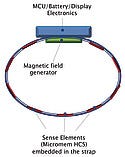April 14, 2009
Click to enlarge |
A diagram of MASTInc's life watch concept shows the sensor arrays for detecting the magnetic-moment behaviors of glucose molecules in the blood. |
Blood analysis is a vital aspect of medical diagnostics, especially for individuals with diseases such as diabetes who must prick their fingers several times a day to monitor blood glucose levels. However, while drawing blood is only mildly invasive, patients and healthcare providers alike would gladly forgo it if they were presented with alternatives. One company is working on just such an alternative: magnetic sensors that can read the wealth of information contained in a single drop of blood.
Micromem Applied Sensor Technologies Inc. (MASTInc; New York City; www.mastinc.com) is developing magnetic sensors and sensor arrays that enable noninvasive diagnostic testing of blood, fluids, and tissue to identify and manage a variety of medical conditions, including diabetes and hypoxia. Consisting of an array of tiny magnetic sensors surrounded by a magnetic source, the technology is designed to be inserted into a future end device worn on the wrist called a 'life watch.'
The life watch concept involves using the sensors to continuously transmit magnetic energy at very low levels from the device into the arm. After absorbing the magnetic energy, the body returns a signal to the sensor array that indicates glucose levels and alerts patients to excursions. In the event of dangerous or life-threatening situations, others are alerted via wireless connectivity. For future glucose monitoring devices, the company says that its magnetic sensors will be calibrated to detect the specific magnetic-moment behaviors of glucose molecules in the blood at certain frequencies and measure these levels in a known unit volume.
"Everything in the world exhibits a unique magnetic signature," explains MASTInc.'s president Steven Van Fleet. The problem is that no existing technology can achieve all three characteristics of ideal molecular imaging capable of deciphering that signature: high sensitivity, minimal background noise, and high temporal-spatial resolution. However, improved imaging specificity is possible if pathology is understood as the morphological and physiological consequences of deregulated molecular pathways, if the quality and diagnostic value of an image is characterized by its spatial resolution, and if target-specific or molecular imaging exploits molecular processes to generate image contrast, according to Van Fleet. "It is from these three challenges that the use of magnetic glucose signatures and other future markers represents a novel approach to medical diagnosis," he concludes.
The company's magnetic sensor array technology can be adapted to identify and measure any micronutrient or substance in the body with a unique magnetic signature, according to Van Fleet. Consequently, the company thinks that it can extend the invention to perform a range of other functions, including hypoxia detection, drug- and toxin-level monitoring, and portable field diagnostic medicine.
Copyright ©2009 Medical Product Manufacturing News
You May Also Like



